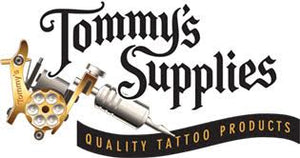Shading Like a Pro: Tools, Techniques, and Ink Flow Tips

TL;DR:
Tattoo shading is a nuanced skill that requires the right tools, consistent ink flow, and solid technique. New artists often struggle with trauma to the skin, inconsistent gradients, and machine control. This guide breaks down the essential tools, needle types, machine settings, hand movements, and aftercare practices to help beginners shade cleanly and confidently—without overworking the skin.
Shading is where tattoos come to life. It adds depth, texture, and realism—but for new artists, it’s also where mistakes can lead to skin damage, blown-out lines, or patchy saturation. Unlike lining, shading demands a softer touch and a greater sensitivity to skin response, ink saturation, and needle speed.
This guide breaks down the tools, techniques, and ink flow tips every beginner artist should master to shade like a pro—while keeping skin trauma to a minimum.
1. Understanding the Tools: Machines, Needles, and Power Supplies
Coil vs Rotary Machines:
Rotary machines are often preferred for shading due to their smoother, more consistent motion. Coil machines can still be used effectively, but they require more tuning and control.
Needle Types for Shading:
- Magnum (M1): Ideal for filling large areas smoothly.
- Curved Magnum (CM or RM): Softer edge, great for gradients.
- Round Shaders (RS): Useful for tighter spaces or blending around lines.
Pro tip: Use curved magnums for soft gradients and round shaders for small, compact shading near detailed line work.
Power Supply Settings:
Voltage for shading typically ranges between 7.5–9V, depending on the machine. Too high can overwork the skin; too low leads to patchy ink.
2. Needle Depth and Hand Speed: The Balancing Act
Needle Depth:
You want the needles to hit the dermis, not the subcutaneous layer. For shading, you’ll often run your needle slightly shallower than you would for lining to avoid trauma.
Hand Speed and Machine Speed:
- Slower hand speed + lower voltage = more saturation
- Faster hand speed + higher voltage = lighter shading
Keep your strokes smooth and even. Inconsistency here leads to patchy shading or overworked areas.
3. Shading Techniques to Practice
Whip Shading:
A flicking motion that starts deep and lifts out gradually, creating a gradient. Excellent for soft fades and black-and-grey work.
Pendulum Shading:
A swinging side-to-side motion—great for even distribution over larger areas.
Circular Motion:
Small, tight circles for soft saturation. Best used for smooth blending and layering tones.
Packing:
Slow, tight movement with consistent pressure—used for solid fill, not gradients.
Each technique produces different effects. It’s crucial to practice each on synthetic skin and observe how ink settles over time.
4. Controlling Ink Flow and Dilution
Ink Flow:
Too much ink causes pooling; too little creates gaps. Use quality ink caps, smooth needle groupings, and avoid overloading your tip.
Diluting Ink:
Grey wash shading requires precise dilution with distilled water or witch hazel. Ratios like 1:1 (medium wash) or 1:4 (light wash) help control tone values.
Test on practice skin before using on clients, as diluted inks can look different once healed.
5. Skin Trauma: Avoiding the Rookie Mistake
Common beginner mistake: going over the same area multiple times trying to “perfect” the blend. This leads to overworked skin, which heals poorly and looks patchy or scarred.
Signs you’re overworking:
- Redness beyond normal irritation
- Ink pooling in plasma
- Skin feels hot or raised
If in doubt, let the skin rest. You can always add more in a follow-up session.
6. Aftercare and Healing Tips for Shaded Tattoos
Shading can be more sensitive than linework. Proper aftercare is essential for pigment retention and skin health.
- Use breathable bandages (like Saniderm)
- Recommend fragrance-free, non-petroleum ointments
- Advise against sun exposure or soaking for 2 weeks
- Remind clients: flaking ≠ fading; it’s part of healing
7. Practice and Progression
Before tattooing real skin, hone your skills on:
- Silicone practice pads
- Fruit (e.g., grapefruit or banana peels)
- Pig skin (used in formal training programs)
Record your progress. Photograph before and after healing to understand how your shading holds up long-term.
FAQ
Q: What’s the best needle for smooth gradients?
A: Curved magnums (CM or RM) are ideal because they deliver softer edges and reduce the risk of harsh lines.
Q: How do I know if my voltage is too high for shading?
A: If the skin is getting too red, ink is spraying, or the sound is erratic, your voltage may be too high. Lower it until the machine runs smoothly and ink deposits evenly.
Q: Can I use the same machine for both lining and shading?
A: Yes, but with rotary machines it’s easier to switch between tasks. Coil machines typically require different setups for each.
Q: Why is my shading patchy even though I used the right needle?
A: It could be due to inconsistent hand speed, uneven pressure, poor ink flow, or going too shallow. Try adjusting one factor at a time during practice.
Q: Do I need to dilute black ink for every shading job?
A: No. Solid black fill doesn’t need dilution, but black and grey styles often use diluted washes for soft gradients.
Conclusion
Mastering shading is about more than just filling space—it’s a balance of technique, control, and skin respect. With the right tools, practiced techniques, and a deep understanding of ink flow, new artists can begin shading confidently without compromising skin health. As with every element of tattooing, patience, observation, and continuous learning are what truly separate pros from beginners.










